Obtaining up-to-date information, facts, figures as well as case studies and viewpoints on important current development and human rights issues has never been easier. Apart from being available on the Internet, such materials are easily accessed through a number of important international reports which are published annually or bi-annually.
This section reviews some of these reports and what is available in them and suggests some ways in which they might be of use. Some are available free on-line, others are found in public libraries – or ask for them to be ordered.
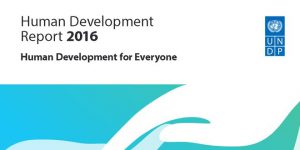 The Human Development Report is published every year. It is the most easily accessible and readable of all the international reports and contains a great amount of immediately useable information. The report is compiled by the United Nations Development Programme (UNDP) and has been published since 1990. Each edition covers a particular theme. The theme for 2016 is ‘Human Development for Everyone’ and comes loaded with: facts and figures, case studies, diagrams, ‘think’ pieces, arguments and viewpoints as well as the annual update tables on key data by country and theme. The materials are particularly easy to use and are great for debates, discussions and research.
This is one of the two international report every library should have (you can download your own free copy online.
The Human Development Report is published every year. It is the most easily accessible and readable of all the international reports and contains a great amount of immediately useable information. The report is compiled by the United Nations Development Programme (UNDP) and has been published since 1990. Each edition covers a particular theme. The theme for 2016 is ‘Human Development for Everyone’ and comes loaded with: facts and figures, case studies, diagrams, ‘think’ pieces, arguments and viewpoints as well as the annual update tables on key data by country and theme. The materials are particularly easy to use and are great for debates, discussions and research.
This is one of the two international report every library should have (you can download your own free copy online.
 Published every two years by the World Wildlife Fund and five other organisations, the Living Planet Report is a must for those concerned about the future of our planet in all its dimensions. It comes with case studies, detailed data and graphics, illustrative stories, stunning photography plus extensive analysis of the challenges of sustainable development. The 2016 edition summarises the state of the natural world today; the impact of humans; some root causes of the current crisis and the nature of a ‘resilient planet’. Very easily and immediately useable.
This is the second international report every library should have and, again, you can download your own free copy online. There is also a 4-page summary available online.
Published every two years by the World Wildlife Fund and five other organisations, the Living Planet Report is a must for those concerned about the future of our planet in all its dimensions. It comes with case studies, detailed data and graphics, illustrative stories, stunning photography plus extensive analysis of the challenges of sustainable development. The 2016 edition summarises the state of the natural world today; the impact of humans; some root causes of the current crisis and the nature of a ‘resilient planet’. Very easily and immediately useable.
This is the second international report every library should have and, again, you can download your own free copy online. There is also a 4-page summary available online.
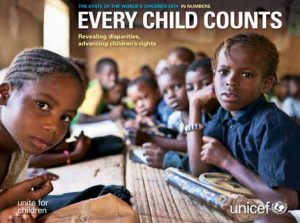 Published by UNICEF, the State of the World’s Children Report is particularly strong on presenting case study material around issues primarily, but not exclusively, affecting women and children. The report includes detailed statistics on the basics, but pays particular attention to the areas of nutrition, health, education, as well as other social development indicators. Also included are excellent historical reviews of key areas including the evolution of UN agreements, etc.
Each year’s report emphasises a particular theme – for 2016 the theme is: A Fair Chance for Every Child, arguing ‘every child has the right to a fair chance in life. But around the world, millions of children are trapped in an intergenerational cycle of disadvantage that endangers their futures – and the future of their societies’. The online version also includes photo stories and embedded videos.
Published by UNICEF, the State of the World’s Children Report is particularly strong on presenting case study material around issues primarily, but not exclusively, affecting women and children. The report includes detailed statistics on the basics, but pays particular attention to the areas of nutrition, health, education, as well as other social development indicators. Also included are excellent historical reviews of key areas including the evolution of UN agreements, etc.
Each year’s report emphasises a particular theme – for 2016 the theme is: A Fair Chance for Every Child, arguing ‘every child has the right to a fair chance in life. But around the world, millions of children are trapped in an intergenerational cycle of disadvantage that endangers their futures – and the future of their societies’. The online version also includes photo stories and embedded videos.
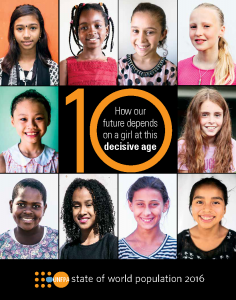 This is published by the United Nations Population Fund (www.unfpa.org). It contains facts and figures on current population statistics, including future population projections; case studies of specific programmes, issues and countries; and different perspectives on controversial issues.
The theme for the 2015 report is Shelter from the Storm focused on the situation of women and children in a crisis-prone world.
This is published by the United Nations Population Fund (www.unfpa.org). It contains facts and figures on current population statistics, including future population projections; case studies of specific programmes, issues and countries; and different perspectives on controversial issues.
The theme for the 2015 report is Shelter from the Storm focused on the situation of women and children in a crisis-prone world.
 Published annually by the International Food Policy Research Institute supported by a number of NGOs (including Concern Worldwide), the Global Hunger Index is a great place to begin exploring the topic. The Index contains global, regional and national data on hunger; a discussion on how it is measured (and how the Index is calculated; interactive materials, maps and factsheets. You can download a free PDF version on the site.
Also has a very useful 20-page African edition
Published annually by the International Food Policy Research Institute supported by a number of NGOs (including Concern Worldwide), the Global Hunger Index is a great place to begin exploring the topic. The Index contains global, regional and national data on hunger; a discussion on how it is measured (and how the Index is calculated; interactive materials, maps and factsheets. You can download a free PDF version on the site.
Also has a very useful 20-page African edition
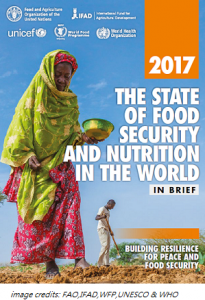 This report is published by the UN Food and Agriculture Organisation with the latest full-edition available for 2015 and with the latest data updates available on https://www.fao.org/hunger/en/.
Offers detailed international and country data, issue case studies, theme –based analyses and perspectives. You can download a free copy of the Report in brief from the site.
This report is published by the UN Food and Agriculture Organisation with the latest full-edition available for 2015 and with the latest data updates available on https://www.fao.org/hunger/en/.
Offers detailed international and country data, issue case studies, theme –based analyses and perspectives. You can download a free copy of the Report in brief from the site.
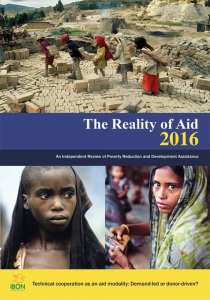 The report’s real value lies in its critical analysis of official aid; its use of case studies and county profiles and diagrams and graphs.
Statistics on international aid are relatively easy to come by, as most official and voluntary aid agencies are anxious to promote themselves and their work. Information on official aid programmes can be obtained from the annual reports or the websites of government aid programmes for example:
The report’s real value lies in its critical analysis of official aid; its use of case studies and county profiles and diagrams and graphs.
Statistics on international aid are relatively easy to come by, as most official and voluntary aid agencies are anxious to promote themselves and their work. Information on official aid programmes can be obtained from the annual reports or the websites of government aid programmes for example:
 This factbook was first published in 2005, and is available annually (latest 2015-2016) and can be read online free. The resource comprises statistical information for OECD member countries (limited non-member information) with indicators covering a wide range of areas: economy, agriculture, education, energy, environment, foreign aid, health and quality of life, industry, information and communications, population/labour force, trade and investment, taxation, public expenditure and Research & Development.
Includes: indicators with descriptions, statistical tables, graphics, comments on comparability of data, an assessment of long-term trends, and a list of references for further information.
The data can be accessed section by section with a very useful index to identify your interest areas.
This factbook was first published in 2005, and is available annually (latest 2015-2016) and can be read online free. The resource comprises statistical information for OECD member countries (limited non-member information) with indicators covering a wide range of areas: economy, agriculture, education, energy, environment, foreign aid, health and quality of life, industry, information and communications, population/labour force, trade and investment, taxation, public expenditure and Research & Development.
Includes: indicators with descriptions, statistical tables, graphics, comments on comparability of data, an assessment of long-term trends, and a list of references for further information.
The data can be accessed section by section with a very useful index to identify your interest areas.
 This is a periodic report from the United Nations Statistics Division of the Department of Economic and Social Affairs (DESA).
First published in 1990, the first 3 editions focused on statistical trends in the situation of women. The report focuses on sex-disaggregated statistics in the areas of health, education, work, violence against women, demographics, poverty, human rights and decision-making. While it looks academic and sometimes difficult to read, it is nonetheless full of useful and relevant materials on issues such as violence against women, power and decision-making, where statistics are particularly difficult to find.
This is a periodic report from the United Nations Statistics Division of the Department of Economic and Social Affairs (DESA).
First published in 1990, the first 3 editions focused on statistical trends in the situation of women. The report focuses on sex-disaggregated statistics in the areas of health, education, work, violence against women, demographics, poverty, human rights and decision-making. While it looks academic and sometimes difficult to read, it is nonetheless full of useful and relevant materials on issues such as violence against women, power and decision-making, where statistics are particularly difficult to find.
 A yearly report published by the US-based NGO Freedom House and offers a measure of the degree of civil liberties and political rights worldwide and regionally. The report provides detailed human rights data country by country, regionally and internationally with tables, graphics and case studies. Each year focuses on a theme (2016 – Anxious Dictators, Wavering Democracies: Global Freedom under Pressure) reviewing broad patterns and trends on key specific themes.
A rich and useable resource with directly accessible materials for workshops or classes as well as research or debate projects. It can be downloaded free from the site.
A yearly report published by the US-based NGO Freedom House and offers a measure of the degree of civil liberties and political rights worldwide and regionally. The report provides detailed human rights data country by country, regionally and internationally with tables, graphics and case studies. Each year focuses on a theme (2016 – Anxious Dictators, Wavering Democracies: Global Freedom under Pressure) reviewing broad patterns and trends on key specific themes.
A rich and useable resource with directly accessible materials for workshops or classes as well as research or debate projects. It can be downloaded free from the site.
Jump to:
The Human Development Report (HDR) | Living Planet Report | State of the World’s Children Report (HDR) | State of World Population Report | The World Development Report | Global Hunger Index | The State of Food Insecurity in the World | The Reality of Aid Report | OECD Factbook | Progress of the World’s Women | Freedom in the World
*Note: educator’s guide to using international reports coming soon.The United Nations Human Development Report (HDR)
– one of the most important and most useful reports The Human Development Report is published every year. It is the most easily accessible and readable of all the international reports and contains a great amount of immediately useable information. The report is compiled by the United Nations Development Programme (UNDP) and has been published since 1990. Each edition covers a particular theme. The theme for 2016 is ‘Human Development for Everyone’ and comes loaded with: facts and figures, case studies, diagrams, ‘think’ pieces, arguments and viewpoints as well as the annual update tables on key data by country and theme. The materials are particularly easy to use and are great for debates, discussions and research.
This is one of the two international report every library should have (you can download your own free copy online.
The Human Development Report is published every year. It is the most easily accessible and readable of all the international reports and contains a great amount of immediately useable information. The report is compiled by the United Nations Development Programme (UNDP) and has been published since 1990. Each edition covers a particular theme. The theme for 2016 is ‘Human Development for Everyone’ and comes loaded with: facts and figures, case studies, diagrams, ‘think’ pieces, arguments and viewpoints as well as the annual update tables on key data by country and theme. The materials are particularly easy to use and are great for debates, discussions and research.
This is one of the two international report every library should have (you can download your own free copy online.
Living Planet Report
– the key environmental overview resource Published every two years by the World Wildlife Fund and five other organisations, the Living Planet Report is a must for those concerned about the future of our planet in all its dimensions. It comes with case studies, detailed data and graphics, illustrative stories, stunning photography plus extensive analysis of the challenges of sustainable development. The 2016 edition summarises the state of the natural world today; the impact of humans; some root causes of the current crisis and the nature of a ‘resilient planet’. Very easily and immediately useable.
This is the second international report every library should have and, again, you can download your own free copy online. There is also a 4-page summary available online.
Published every two years by the World Wildlife Fund and five other organisations, the Living Planet Report is a must for those concerned about the future of our planet in all its dimensions. It comes with case studies, detailed data and graphics, illustrative stories, stunning photography plus extensive analysis of the challenges of sustainable development. The 2016 edition summarises the state of the natural world today; the impact of humans; some root causes of the current crisis and the nature of a ‘resilient planet’. Very easily and immediately useable.
This is the second international report every library should have and, again, you can download your own free copy online. There is also a 4-page summary available online.
State of the World’s Children Report
– health, education, nutrition, women and children Published by UNICEF, the State of the World’s Children Report is particularly strong on presenting case study material around issues primarily, but not exclusively, affecting women and children. The report includes detailed statistics on the basics, but pays particular attention to the areas of nutrition, health, education, as well as other social development indicators. Also included are excellent historical reviews of key areas including the evolution of UN agreements, etc.
Each year’s report emphasises a particular theme – for 2016 the theme is: A Fair Chance for Every Child, arguing ‘every child has the right to a fair chance in life. But around the world, millions of children are trapped in an intergenerational cycle of disadvantage that endangers their futures – and the future of their societies’. The online version also includes photo stories and embedded videos.
Published by UNICEF, the State of the World’s Children Report is particularly strong on presenting case study material around issues primarily, but not exclusively, affecting women and children. The report includes detailed statistics on the basics, but pays particular attention to the areas of nutrition, health, education, as well as other social development indicators. Also included are excellent historical reviews of key areas including the evolution of UN agreements, etc.
Each year’s report emphasises a particular theme – for 2016 the theme is: A Fair Chance for Every Child, arguing ‘every child has the right to a fair chance in life. But around the world, millions of children are trapped in an intergenerational cycle of disadvantage that endangers their futures – and the future of their societies’. The online version also includes photo stories and embedded videos.
World Population – 2 key sources on this key issue
An annually updated population overview is provided online by the UN Department of Economic and Social Affairs Population Division (here’s the 2017 edition). The full report is available online and includes 6 separate sections highlighting the key findings for that year, the data tables and graphs, the press release etc. The interactive data section is easy to use and allows you to tailor your search to specific needs and interests.The State of World Population Report
 This is published by the United Nations Population Fund (www.unfpa.org). It contains facts and figures on current population statistics, including future population projections; case studies of specific programmes, issues and countries; and different perspectives on controversial issues.
The theme for the 2015 report is Shelter from the Storm focused on the situation of women and children in a crisis-prone world.
This is published by the United Nations Population Fund (www.unfpa.org). It contains facts and figures on current population statistics, including future population projections; case studies of specific programmes, issues and countries; and different perspectives on controversial issues.
The theme for the 2015 report is Shelter from the Storm focused on the situation of women and children in a crisis-prone world.
The World Development Report (WDR)
– the old heavyweight reference…and a new atlas Link to the 2017 edition Each year since 1977, the World Bank has published its World Development Report which remains one of the main reference works on development, in particular its economic dimensions. While not easy to read or use, it is a major source of information especially statistical information. WDR also focuses on an annual theme – for 2017 the theme is Governance and the Law. Most of the data is now directly available online with region, country and theme information accessible separately on https://data.worldbank.org/ with a useful Get Started section on using the site. Also from the World Bank, the Atlas of Sustainable Development Goals 2017 offers very rich pickings with regard to the core SDG themes. It is full of maps, data, analysis and first-class graphics and stimulus materials which are immediately useable and informative especially if you are planning a class or workshop. A must for anyone reviewing the SDG agenda – you can download your own copy free.State of World Hunger – the core data, analysis and argument in 2 reports
Global Hunger Index
 Published annually by the International Food Policy Research Institute supported by a number of NGOs (including Concern Worldwide), the Global Hunger Index is a great place to begin exploring the topic. The Index contains global, regional and national data on hunger; a discussion on how it is measured (and how the Index is calculated; interactive materials, maps and factsheets. You can download a free PDF version on the site.
Also has a very useful 20-page African edition
Published annually by the International Food Policy Research Institute supported by a number of NGOs (including Concern Worldwide), the Global Hunger Index is a great place to begin exploring the topic. The Index contains global, regional and national data on hunger; a discussion on how it is measured (and how the Index is calculated; interactive materials, maps and factsheets. You can download a free PDF version on the site.
Also has a very useful 20-page African edition
The State of Food Insecurity in the World
 This report is published by the UN Food and Agriculture Organisation with the latest full-edition available for 2015 and with the latest data updates available on https://www.fao.org/hunger/en/.
Offers detailed international and country data, issue case studies, theme –based analyses and perspectives. You can download a free copy of the Report in brief from the site.
This report is published by the UN Food and Agriculture Organisation with the latest full-edition available for 2015 and with the latest data updates available on https://www.fao.org/hunger/en/.
Offers detailed international and country data, issue case studies, theme –based analyses and perspectives. You can download a free copy of the Report in brief from the site.
The Reality of Aid Report
The Reality of Aid Report is published by a consortium of NGOs. Each report contains a review of aid facts and figures, essays on current issues and themes, and most importantly and unusually, a section on perspectives from the South (on aid) plus profiles of individual country aid programmes. The report’s real value lies in its critical analysis of official aid; its use of case studies and county profiles and diagrams and graphs.
Statistics on international aid are relatively easy to come by, as most official and voluntary aid agencies are anxious to promote themselves and their work. Information on official aid programmes can be obtained from the annual reports or the websites of government aid programmes for example:
The report’s real value lies in its critical analysis of official aid; its use of case studies and county profiles and diagrams and graphs.
Statistics on international aid are relatively easy to come by, as most official and voluntary aid agencies are anxious to promote themselves and their work. Information on official aid programmes can be obtained from the annual reports or the websites of government aid programmes for example:
- Figures for Irish Aid – www.irishaid.ie
- DFID in the UK – www.dfid.uk
- Most of the government aid programmes can be found by searching the official government websites – www.gksoft.com/govt/en
OECD Factbook – Economic, Environmental and Social Statistics
 This factbook was first published in 2005, and is available annually (latest 2015-2016) and can be read online free. The resource comprises statistical information for OECD member countries (limited non-member information) with indicators covering a wide range of areas: economy, agriculture, education, energy, environment, foreign aid, health and quality of life, industry, information and communications, population/labour force, trade and investment, taxation, public expenditure and Research & Development.
Includes: indicators with descriptions, statistical tables, graphics, comments on comparability of data, an assessment of long-term trends, and a list of references for further information.
The data can be accessed section by section with a very useful index to identify your interest areas.
This factbook was first published in 2005, and is available annually (latest 2015-2016) and can be read online free. The resource comprises statistical information for OECD member countries (limited non-member information) with indicators covering a wide range of areas: economy, agriculture, education, energy, environment, foreign aid, health and quality of life, industry, information and communications, population/labour force, trade and investment, taxation, public expenditure and Research & Development.
Includes: indicators with descriptions, statistical tables, graphics, comments on comparability of data, an assessment of long-term trends, and a list of references for further information.
The data can be accessed section by section with a very useful index to identify your interest areas.
Progress of the World’s Women Report
 This is a periodic report from the United Nations Statistics Division of the Department of Economic and Social Affairs (DESA).
First published in 1990, the first 3 editions focused on statistical trends in the situation of women. The report focuses on sex-disaggregated statistics in the areas of health, education, work, violence against women, demographics, poverty, human rights and decision-making. While it looks academic and sometimes difficult to read, it is nonetheless full of useful and relevant materials on issues such as violence against women, power and decision-making, where statistics are particularly difficult to find.
This is a periodic report from the United Nations Statistics Division of the Department of Economic and Social Affairs (DESA).
First published in 1990, the first 3 editions focused on statistical trends in the situation of women. The report focuses on sex-disaggregated statistics in the areas of health, education, work, violence against women, demographics, poverty, human rights and decision-making. While it looks academic and sometimes difficult to read, it is nonetheless full of useful and relevant materials on issues such as violence against women, power and decision-making, where statistics are particularly difficult to find.
Freedom in the World Report
 A yearly report published by the US-based NGO Freedom House and offers a measure of the degree of civil liberties and political rights worldwide and regionally. The report provides detailed human rights data country by country, regionally and internationally with tables, graphics and case studies. Each year focuses on a theme (2016 – Anxious Dictators, Wavering Democracies: Global Freedom under Pressure) reviewing broad patterns and trends on key specific themes.
A rich and useable resource with directly accessible materials for workshops or classes as well as research or debate projects. It can be downloaded free from the site.
A yearly report published by the US-based NGO Freedom House and offers a measure of the degree of civil liberties and political rights worldwide and regionally. The report provides detailed human rights data country by country, regionally and internationally with tables, graphics and case studies. Each year focuses on a theme (2016 – Anxious Dictators, Wavering Democracies: Global Freedom under Pressure) reviewing broad patterns and trends on key specific themes.
A rich and useable resource with directly accessible materials for workshops or classes as well as research or debate projects. It can be downloaded free from the site. 